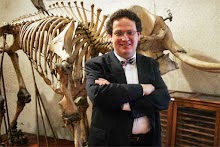The Berlin specimen of Archaeopteryx is fantastically housed and displayed. It is in a small room that adds to the inescapable sense that you are seeing something truly special. Crowds wait their turn to step into the small, dimly lit room where the specimen is on display. The obvious comparison is the chaos in the Louvre as people nudge their way close enough to the Mona Lisa to see her.
The Archaeopteryx is behind bullet proof glass like the U. S. Constitution in Washington, DC, providing exceptional security yet allowing the public to be close enough to examine the impression in detail. When a scientist visits Berlin to study the specimen the room is secured by a closing door with the scientist inside and then the case opens to allow access to the fossil. This is a brilliantly designed and constructed exhibit that through its architectural gravitas conveys to the public that this is an exceptionally valuable specimen. This use of technology to allow the public to be so close to this paleontological treasure while it is not being studied by visiting scientists, yet enable direct access by scientists as needed, is a model that should be carefully studied and adapted to share other rare research specimens with an appreciative and curious public.




No comments:
Post a Comment